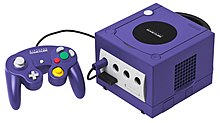 | |
 Indigo system with controller and memory card | |
| Also known as | Dolphin[a] |
|---|---|
| Developer | Nintendo |
| Manufacturer |
|
| Type | Home video game console |
| Generation | Sixth |
| Release date | |
| Introductory price | $199,[5] £129,[6] €199[7] |
| Discontinued |
|
| Units sold |
|
| Media | |
| Operating system | Proprietary |
| CPU | 32-bit IBM PowerPC 750CXe Gekko @ 486 MHz |
| Memory | |
| Removable storage | GameCube Memory Card[b] |
| Display | Video output formats |
| Graphics | ATI Flipper GPU @ 162 MHz with 3 MB embedded 1T-SRAM |
| Sound | Analog stereo[f] |
| Controller input | GameCube controller, WaveBird, GBA, various |
| Connectivity | Ethernet and dialup |
| Power |
|
| Online services | |
| Dimensions |
|
| Mass |
|
| Best-selling game | Super Smash Bros. Melee, 7.09 million[g] |
| Predecessor | Nintendo 64 |
| Successor | Wii |
The Nintendo GameCube[h][i] is a home video game console developed and marketed by Nintendo. It was released in Japan on September 14, 2001, in North America on November 18, 2001, in Europe on May 3, 2002, and in Australia on May 17, 2002. It is the successor to the Nintendo 64. As a sixth-generation console, the GameCube primarily competed with Sony's PlayStation 2, Sega's Dreamcast and Microsoft's Xbox.
Nintendo began developing the GameCube in 1998 after entering a partnership with ArtX to design a graphics processing unit. The console was formally announced under the codename "Dolphin" the following year, and was released in 2001 as the GameCube. It is Nintendo's first console to use its own optical discs instead of ROM cartridges, supplemented by writable memory cards for saved games. Unlike its competitors, it is solely focused on gaming and does not play mass media like DVD or CD.
The console supports limited online gaming for a few games via a GameCube broadband or modem adapter and can connect to a Game Boy Advance with a link cable for exclusive in-game features using the handheld as a second screen and controller. The GameCube supports e-Reader cards to unlock special features in a few games. The Game Boy Player add-on runs Game Boy, Game Boy Color and Game Boy Advance cartridge games.
Reception of the GameCube was mixed. It was praised for its controller and high quality games library, but was criticized for its lack of multimedia features and lack of third party support compared to its competitors. Premier games include Super Mario Sunshine, Super Smash Bros. Melee, Star Fox Adventures, Metroid Prime, Mario Kart: Double Dash, Pikmin, The Legend of Zelda: The Wind Waker, Animal Crossing and Luigi's Mansion. Nintendo sold 21.74 million GameCube units worldwide,[j] much fewer than anticipated, and discontinued it in 2007.[14] It was succeeded by the Wii in late 2006.
Cite error: There are <ref group=lower-alpha> tags or {{efn}} templates on this page, but the references will not show without a {{reflist|group=lower-alpha}} template or {{notelist}} template (see the help page).
- ^ Becker, David (November 29, 2001). "Nintendo Reports Record GameCube Launch". CNET. Archived from the original on October 1, 2013. Retrieved July 8, 2013.
- ^ Williams, Martyn (August 24, 2001). "Nintendo Unveils GameCube Launch Plans". CNN. Archived from the original on June 19, 2022. Retrieved March 16, 2013.
- ^ "GameCube Price Dropped". BBC News. April 22, 2002. Archived from the original on October 2, 2013. Retrieved March 16, 2013.
- ^ Cameron, Nadia (May 20, 2002). "GameCube Launch Rounds Out Console Troika". PC World. Archived from the original on April 10, 2022. Retrieved July 7, 2020.
- ^ Morris, Chris (May 21, 2001). "GameCube to Sell for $199". Money.CNN.com (Press release). New York City. Archived from the original on June 23, 2018. Retrieved September 21, 2018.
- ^ Welsh, Oli (February 24, 2017). "A Complete History of Nintendo Console Launches". Eurogamer. Bath: Future plc. Archived from the original on August 20, 2021. Retrieved December 30, 2021.
- ^ Gieselmann, Hartmut (April 22, 2002). "Nintendo senkt Preis für GameCube". heise online. Archived from the original on July 25, 2022. Retrieved July 25, 2022.
- ^ Cite error: The named reference
Saleswas invoked but never defined (see the help page). - ^ "Nintendo Jumps Online". IGN. June 17, 2012. Archived from the original on March 26, 2020. Retrieved February 20, 2020.
- ^ a b ニンテンドーゲームキューブ取扱説明書. Nintendo. p. 36.
- ^ "At Long Last, Nintendo Proclaims: Let the Brawls Begin on Wii!" (Press release). Redmond, Washington: Nintendo. March 10, 2008. Archived from the original on March 13, 2008. Retrieved March 11, 2008.
The previous installment in the series, Super Smash Bros. Melee, is the best-selling game for Nintendo GameCube with 7.09 million copies sold worldwide.
- ^ Reimer, Jeremy (October 1, 2006). "How the Wii was born | Ars Technica". Archived from the original on May 31, 2012. Retrieved October 17, 2023.
- ^ Reimer, Jeremy (May 1, 2006). "Gamecube price drop imminent? | Ars Technica". Archived from the original on October 22, 2012. Retrieved October 17, 2023.
- ^ Thorsen, Tor (February 22, 2007). "Nintendo officially pulls plug on GameCube?". GameSpot. Retrieved October 17, 2023.